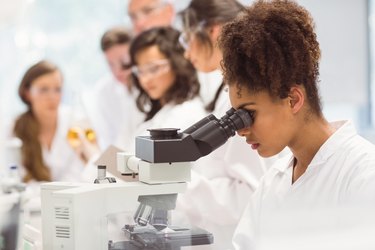
Bacteria are the oldest and most abundant life form on Earth. These microscopic, single-celled organisms live in all environments -- including in and on the human body. A study published in May 2016 in the "Proceedings of the National Academy of Sciences of the U.S.A." estimated there may be as many as 1 trillion different types of bacteria. Most bacteria are harmless to humans, and many that live in and on the body serve beneficial functions. Certain bacteria, however, have the capacity to cause infectious diseases and conditions. Disease-causing, or pathogenic, bacteria can be categorized based on their shape and staining pattern.
Gram-Positive Cocci
Video of the Day
Bacteria are broadly categorized as Gram positive or negative based on their staining characteristics. This distinction is important as it reflects differences in the bacterial wall, which influences its susceptibility to different antibiotics. Certain types of Gram-positive cocci, or spherical bacteria, are the leading pathogens among humans, including: -- Staphylococcus aureus -- Streptococcus pneumoniae -- Streptococcus pyogenes, also known as group A streptococcus
Video of the Day
These bacteria can cause a range of conditions and infections. Common examples include: -- pneumonia -- ear infections -- strep throat -- superficial and deep skin infections -- bloodstream infections, known as sepsis -- toxic shock syndrome
Gram-Negative Cocci
Among the Gram-negative cocci, two specific bacterial species stand out as important human pathogens. Neisseria gonorrhoeae, also known as gonococcus, is the bacteria responsible for the sexually-transmitted infection gonorrhea. Approximately 820,000 new gonorrhea infections occur each year in the U.S., according to the Centers for Disease Control and Prevention. Although gonorrhea is not immediately life-threatening, it can lead to serious health problems such as infertility in women and infectious arthritis. Gonorrhea can also cause serious complications in babies born to mothers with the infection.
Neisseria meningitidis, or meningococcus, is a leading cause of bacterial meningitis -- a life-threatening infection of membranes brain and spinal cord, which can spread throughout the body via the bloodstream. CDC recommends meningococcal vaccination for all preteens and teens, and certain adults at risk for contracting the infection.
Gram-Positive Rods
Several types of Gram-positive, rod-shaped bacteria can cause human disease. Certain species of Clostridium bacteria induce disease by producing powerful toxins. Examples include: -- Clostridium perfringens: gas gangrene and food poisoning -- Clostridium botulimum: botulism -- Clostridium tetani: tetanus -- Clostridium difficile: inflammation of the colon called pseudomembranous colitis
Bacillus anthracis is the bacteria responsible for anthrax, a feared bioterrorism threat. A related species called Bacillus cereus causes food poisoning mediated by toxins the bacteria produce. Listeria monocytogenes causes listeriosis, a serious infection caused by eating food contaminated with the bacteria. With listeriosis, the bacteria typically spreads from the digestive system to other parts of the body. Listeriosis, which is potentially life-threatening, primarily affects newborns, seniors, pregnant women and other people with a weakened immune system.
Gram-Negative Rods
A number of bacterial species in the broad category of Gram-negative rods can cause human infections, which range in severity and site of the body affected. Some notable examples include: -- Escherichia coli, or E. coli: urinary tract infections, food poisoning, meningitis -- Salmonella species: food poisoning and typhoid fever -- Shigella species: food poisoning -- Vibrio species: cholera, food poisoning and wound infections -- Campylobacter species: food poisoning -- Bordetella pertussis: whooping cough -- Haemophilus influenzae: meningitis, sinusitis, ear infections, pneumonia, sepsis -- Legionella species: Legionnaires' disease and Pontiac fever -- Pseudomonas aeruginosa: swimmer's ear, heart infections, sepsis, meningitis, pneumonia, skin infections
Other Notable Bacterial Pathogens
A complete list of bacterial human pathogens numbers in the hundreds. However, a few more notable examples of important disease-causing bacteria that do not fall into the previously listed categories includes: -- Helicobacter pylori: stomach and intestinal ulcers -- Mycobacterium tuberculosis: tuberculosis -- Treponema pallidum: syphilis -- Borrelia burgdorferi: Lyme disease -- Chlamydia trachomatis: chlamydia -- Rickettsia species: Rocky Mountain spotted fever, typhus and other diseases spread by tick, mite or flea bites
Reviewed and revised by: Tina M. St. John, M.D.
- Proceedings of the National Academy of Sciences of the United States of America: Scaling Laws Predict Global Microbial Diversity
- Todar's Online Textbook of Bacteriology: Bacterial Pathogens of Humans
- Centers for Disease Control and Prevention: 2015 Sexually Transmitted Diseases Treatment Guidelines: Gonococcal Infections
- Centers for Disease Control and Prevention: Meningococcal: Who Needs to Be Vaccinated?
- Centers for Disease Control and Prevention: Listeria (Listeriosis)
Is this an emergency? If you are experiencing serious medical symptoms, please see the National Library of Medicine’s list of signs you need emergency medical attention or call 911.